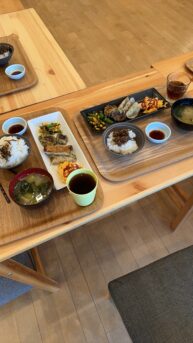I did two activities for my CIP, golf lessons and bouldering. There were no set meeting dates, but for me, both were about once a week occurrences that were markedly different in terms of community interaction.
I took my golf lessons at 72 Golf, an indoor school located at Kawaramachi Imadegawa. There would always be one teacher on post and anywhere from between one to four students. The teacher would rotate among the students, giving them advice on how to improve during each of their one hour lessons.
I’m glad I took the time to learn golf during my time in Kyoto, but in retrospect, golf lessons were probably not the best choice for a CIP. Because students are usually only focused on practicing and improving their swing during the short hour they’re there, our interactions were limited to speaking with our teacher. With that being said, I did get to practice using Japanese in a different setting, and also was able to notice some language nuances like how “ありがとうございます” could be used as a farewell greeting when leaving the school, or even to abruptly end a conversation (in this case, being said from teacher to student).
For bouldering, I would go to a climbing gym at Shijo, and usually stay for anywhere between two to four hours. The community feel here was noticeably different, and I was personally surprised to find how open all the climbers were with each other. It wouldn’t be uncommon at all to find myself being cheered on by strangers with phrases like “頑張,” “うまい,” and “ナイス” while I was in the middle of climbing a more difficult course, and then finding myself greeted at the end by a congratulatory fist bump if I reached the goal.
Among some of the language-related things I found interesting was how the phrase “化け物だ” is used in the exact same way young English-speakers use a similar phrase when acknowledging someone’s level of skill (e.g., “you’re a monster”). Occasionally I would hear this compliment directed toward some of the more experienced climbers that frequented the climbing gym.
Through the bouldering gym, I’ve met a number of Japanese people from a variety of ages and backgrounds, and even got to spend time outside the bouldering gym with those who I were able to click with more. I’ve gotten two or three dinners so far with some of the other climbers, and it does help to be more proactive in inviting others. With some friends, after getting to know them more, they would also start speaking in casual language with me.
Although I was very much a beginner when I started this semester, and received a lot of guidance from other climbers around me, I’ve finally gotten to a level where I can teach newcomers how to climb some of the simpler courses. The friendly environment at the bouldering gym helps to facilitate lots of interactions, and now I usually initiate conversations just as often as they come to me. By both teaching and continuing to be taught, I’ve been able to speak in Japanese quite frequently every time I visit.
All in all, both my CIPs were very much enjoyable, but in terms of a community feel and language practice, I would recommend bouldering for those who don’t mind dealing with sore arms the first few times.





